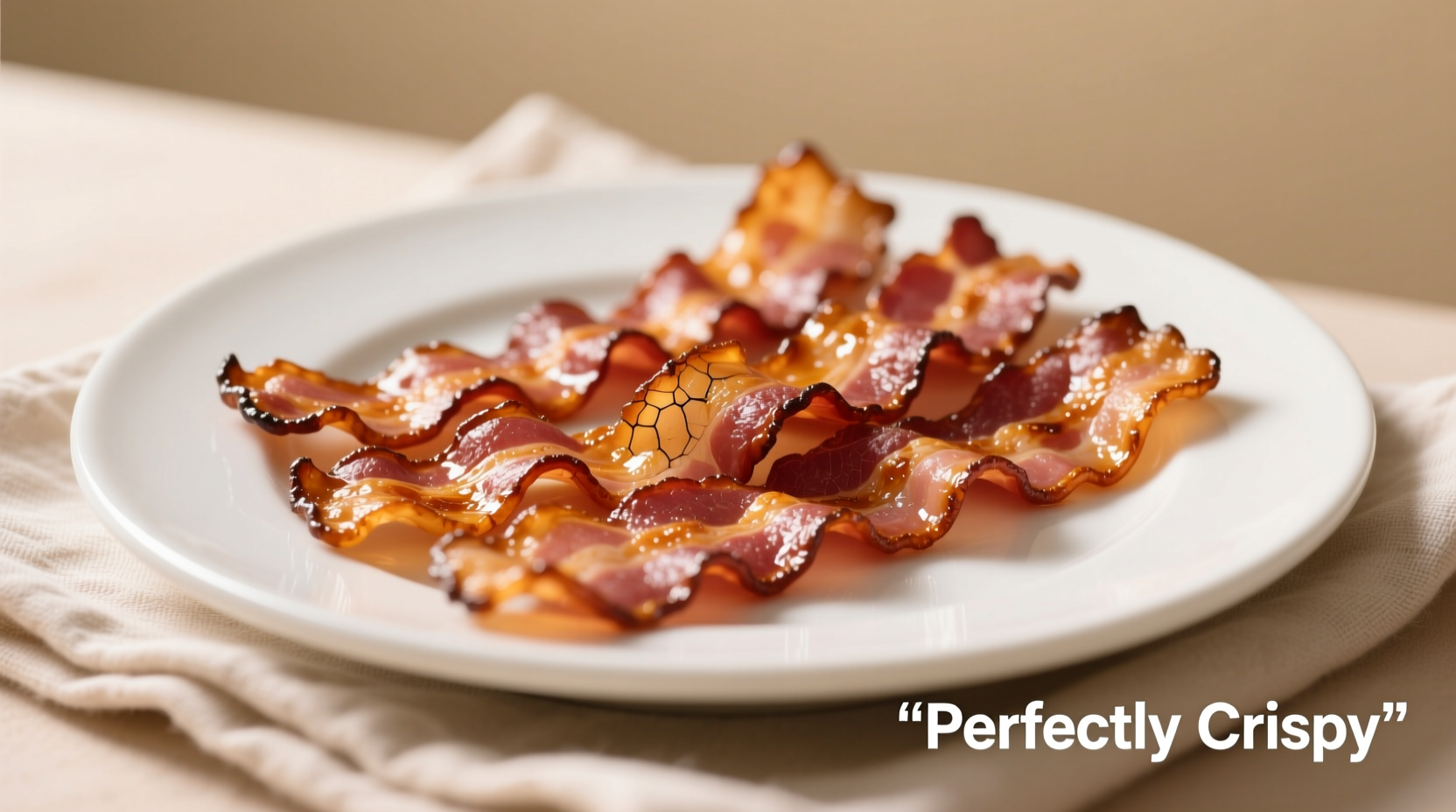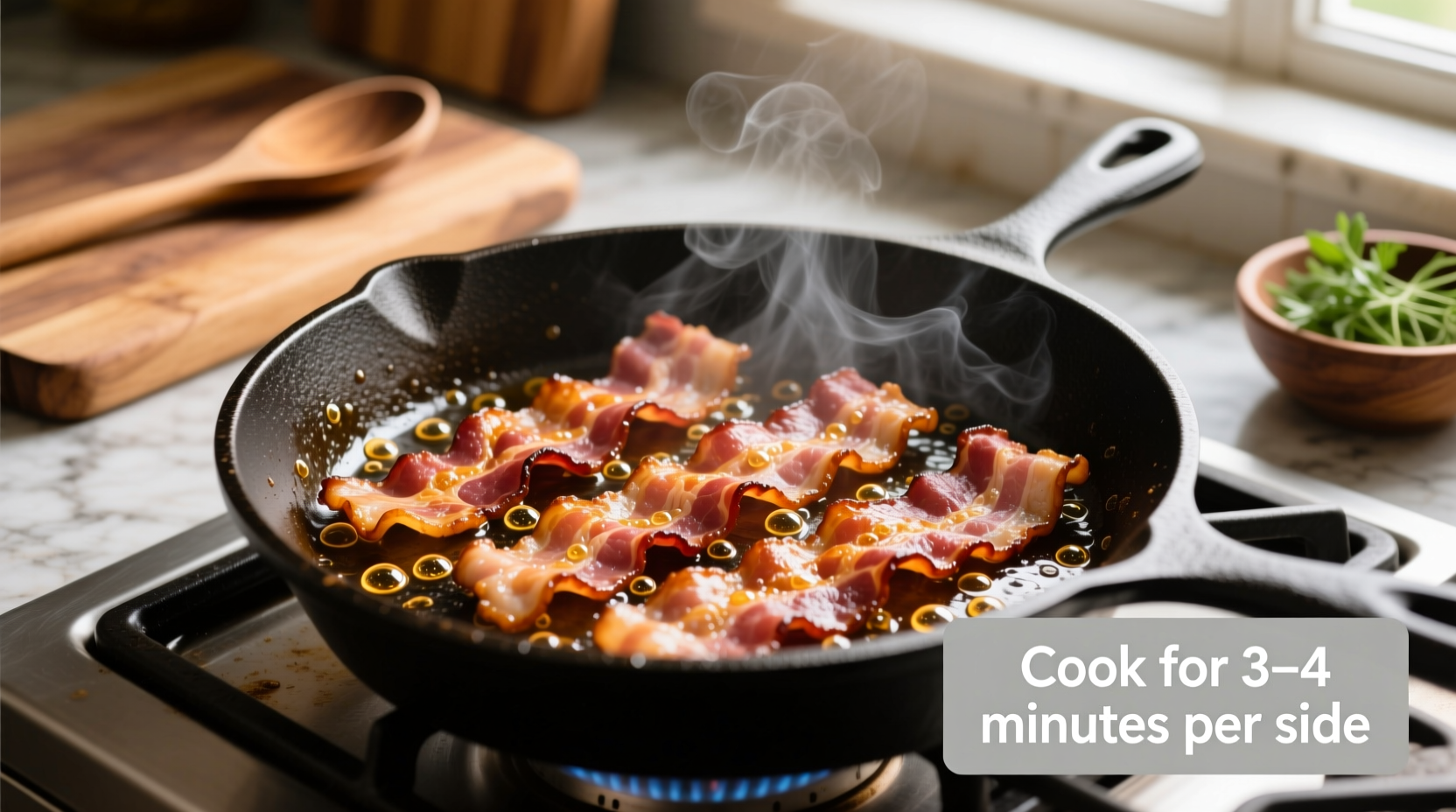Perfectly cooked bacon takes 8-12 minutes on the stovetop, 15-20 minutes in a 400°F oven, or 3-5 minutes in the microwave. Actual timing depends on bacon thickness, starting temperature, cooking method, and desired crispiness level. Always watch for visual cues like golden-brown color and bubbling fat rather than relying solely on time.
The Science Behind Perfectly Cooked Bacon
Getting bacon right isn't just about timing—it's understanding the cooking process. As bacon heats, its fat renders while proteins denature and undergo the Maillard reaction, creating that signature flavor and color. The USDA recommends cooking pork products to a minimum internal temperature of 145°F (63°C) with a 3-minute rest period for food safety, though bacon's thinness means temperature checks are impractical.
Professional chefs at the Culinary Institute of America emphasize that visual and auditory cues matter more than strict timing. As bacon cooks, you'll notice distinct stages: the fat begins to liquefy around 110°F (43°C), the meat changes from pink to brown between 140-150°F (60-66°C), and the Maillard reaction intensifies above 300°F (149°C).

Stovetop Method: Your Most Common Approach
Most home cooks start with a cold skillet—this gradual heating allows even fat rendering without burning. For standard-cut bacon:
- Cold start method: 8-10 minutes total (flip once when bubbles appear)
- Preheated pan: 6-8 minutes total (requires more attention)
Thick-cut bacon needs 2-4 extra minutes. The critical indicator? When the fat turns translucent and the edges curl slightly. Overcooking happens quickly in the final minutes, so check frequently once bacon reaches golden color.
Oven Baking: The Hands-Off Technique
For consistent results with minimal supervision:
- Preheat oven to 400°F (204°C)
- Arrange bacon on wire rack over baking sheet (or directly on sheet)
- Cook for 15-20 minutes (18-22 for thick-cut)
This method produces evenly crisp bacon because hot air circulates around all sides. Food Network's test kitchen confirms oven-baked bacon requires 25% less active monitoring than stovetop methods while yielding more consistent results across multiple strips.
| Cooking Method | Standard Bacon Time | Thick-Cut Time | Best For |
|---|---|---|---|
| Stovetop (cold start) | 8-10 minutes | 10-14 minutes | Small batches, immediate serving |
| Oven (400°F) | 15-18 minutes | 18-22 minutes | Large batches, hands-off cooking |
| Air Fryer (375°F) | 7-9 minutes | 9-12 minutes | Quick cooking, extra crispiness |
| Microwave | 3-5 minutes | 5-7 minutes | Emergency situations only |
Environmental Factors That Change Cooking Time
Your kitchen environment significantly impacts bacon cooking duration:
- Starting temperature: Refrigerated bacon adds 1-2 minutes versus room temperature
- Pan material: Cast iron retains heat better than nonstick, requiring slightly lower heat
- Batch size: Overcrowding drops pan temperature, extending cooking time by 25-30%
- Altitude: At elevations above 3,000 feet, increase time by 5-10% due to lower boiling point
According to the National Center for Home Food Preservation, humidity levels also affect cooking time—high humidity environments may require 1-2 additional minutes as moisture evaporates more slowly from the bacon surface.
Perfect Crispiness: Beyond the Clock
Timing provides a baseline, but these visual and tactile indicators determine perfect doneness:
- Light crisp: Bacon appears golden with flexible texture (remove at 15-16 minutes in oven)
- Medium crisp: Deep golden color with slight resistance when pressed (17-18 minutes)
- Extra crisp: Deep mahogany color with brittle texture (19-20 minutes)
Don't rely solely on appearance—listen for the sizzle to change from vigorous bubbling to gentle crackling, indicating most fat has rendered. The University of California Food Science Department notes that properly cooked bacon should lose 30-40% of its raw weight through fat rendering.
Troubleshooting Common Bacon Problems
Problem: Bacon burns before fat renders
Solution: Start with cold pan and lower heat—never preheat skillet for bacon
Problem: Uneven cooking
Solution: Rotate pan 180 degrees halfway through cooking or use oven method
Problem: Excessive smoking
Solution: Reduce heat slightly and ensure proper ventilation—bacon fat smokes at 325°F (163°C)
Storage and Reheating Guidelines
Cooked bacon keeps 4-5 days refrigerated or 2-3 months frozen. For best reheating results:
- Oven: 350°F for 5-8 minutes on wire rack
- Air fryer: 325°F for 3-4 minutes
- Skillet: Medium heat for 1-2 minutes per side
Avoid microwaving for reheating—it makes bacon leathery rather than crisp. The American Egg Board's cooking guidelines confirm that oven reheating preserves texture best by slowly re-rendering residual fat without creating steam that softens the bacon.











 浙公网安备
33010002000092号
浙公网安备
33010002000092号 浙B2-20120091-4
浙B2-20120091-4